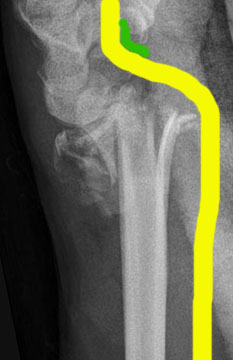David Nelson , MD
Private Practice,
San Francisco
Webmaster, eRadius
Associate Editor, J Hand Surgery
Director, San Francisco Bay Area Hand Club |
 |
(12) What is your diagnosis? What is your proposed next step? The patient had median nerve compromise, probably due to the prolonged tourniquet times (up 2 1/2 hrs, down 25 min, up 2 hours), as well as the minor swelling and dense induration of the distal forearm and hand. In addition, the arm was still recovering from three prior insults: the original injury, the surgery to place the ex fix, and the surgery to place the plates. The magnitude of the original injury can only be guessed, but remember the course of the median nerve, when superimposed on the injury film:

This is the injury film; remember, the distal portion of the radius was displaced much more than this at the time of injury. The course of the median nerve is shown in yellow, and it is retricted in the palm by the transverse carpal ligament (shown in green), which stretches from the trapezial ridge to the hook of the hamate. It does not move when a radius gets fractured, so the nerve has a rather tortuous course.
The median nerve not only is stretched by the deformed anatomy and crushed by the force which fractured the radius, it also is tented over the spike of bone. The FDS III sustained a 50% laceration at the same time, so we can estimate that the nerve was challenged significantly at the same time.
The median nerve had already been decompressed from the distal forearm to the distal palm. It was felt that the median nerve had been properly and completely decompressed previously, further exploration would only add to the induration, and that it might be difficult to close the forearm if it was opened at this time. The problem was discussed with several other hand surgeons, and the consensus was to observe the arm. This decision was not taken lightly (in fact, it generated considerable gastric acid secretion in the surgeon!), was fully discussed with the patient, and the patient was contacted daily and seen frequently.

However, more is going on. The dense induration is a clue that something else may be developing.
(13) What should you look out for?
Jump to Page: 1 2 3 4 5 6 7 8 9 10 11 12 13 14 15 16 17
|
|


